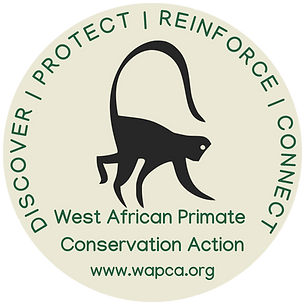







In-situ Projects
The Upper Guinean Rainforest

The Upper Guinean Rainforest is a 350 km-wide stretch of West African coastal rainforest running from Sierra Leone to the Ghana–Togo border. It is recognised as one of the International Union for Conservation of Nature’s (IUCN) 25 Key Biodiversity Areas, part of the World Wide Fund for Nature’s (WWF) Global 200 eco regions, a Conservation International Biodiversity Hotspot, and one of BirdLife International’s Important Bird Areas. Although these Key Biodiversity Areas cover only 1.4% of the Earth’s surface, they hold more than 60% of all known animal and plant species. The Upper Guinean Rainforest is one of the most biologically diverse ecosystems on the African continent, supporting over 1,800 unique plant species, 31 threatened birds, 35 threatened mammals, and 49 threatened amphibians—many of which are found nowhere else in the world.
Within the eastern portion of the Upper Guinean Rainforest, the last remaining large areas of lowland rainforest are now almost entirely confined to eastern Côte d’Ivoire and western Ghana. These forests are home to several rare and threatened primate species.
- Roloway monkey (Cercopithecus roloway)
- White-naped mangabey (Cercocebus lunulatus)
- Miss Waldron’s red colobus (Procolobus waldroni) – possibly extinct
- White-thighed black-and-white colobus (Colobus vellerosus)
- Eastern spot-nosed monkey (Cercopithecus petaurista)
- Lowe’s monkey (Cercopithecus lowei)
- Olive colobus (Procolobus verus)

In addition to primates, these forests are also home to other unique mammals, including the zebra duiker (Cephalophus zebra), royal antelope (Neotragus pygmaeus), Liberian mongoose (Liberiictis kuhni), Dephua mouse (Dephomys eburnea), white-throated shrew (Crocidura wimmeri), and Togo mouse (Leimacomys buettneri).
Threats
Deforestation is the greatest threat to both the environment and the wildlife that depend upon the rainforests of West Africa. According to a recent Critical Ecosystem Partnership Fund (CEPF) Ecosystem Report, the Upper Guinean Forest has been reduced to a mere 15% of its original cover. Logging, unsustainable and poorly managed cocoa and palm oil agriculture, illegal mining (termed “galamsey”), and human encroachment have left only fragmented remnants of rainforest. Studies of legal and illegal logging in Ghana have shown an increase of 600% in 15 years. Illegal logging is the most devastating threat, as it is wholly unmanaged, with no regard for tree species, age, or size. It is carried out by two sources: one-third by legal companies that remove more than their quota or take from protected areas, and two-thirds by illegal chainsaw operators who cut wherever roads provide access. According to Global Forest Watch, between 2001 and 2014 Ghana lost more than half a million hectares of forest, around 9% of its total cover.
Extensive bushmeat hunting for both local consumption and export to other countries has also caused a massive decline in wildlife populations. Estimates of the bushmeat trade run as high as US$400 million per year in Ghana and US$500 million in Côte d’Ivoire. Wildlife in these countries is disappearing at such an alarming rate that many remaining rainforest habitats have become nearly devoid of mammal species, leading conservationists to label these forests as “empty forests”.

The unique fauna and flora of these rainforests have long been under pressure from deforestation and overhunting. With ever-diminishing forest cover in which to retreat, wildlife in these forests are finding there is nowhere left to hide.
Community Resource Managment Areas (CREMAS)

Rural communities depend on the health of the rainforest for their livelihoods, so it is imperative that environmental monitoring and conservation are implemented at the local level. It is also crucial that local people have the knowledge, skills, and economic incentives to manage their resources in ways that sustain natural ecosystem processes.
The Wildlife Division of the Ghana Forestry Commission is currently utilising CREMAs as the primary mechanism for implementing collaborative, sustainable natural resource management outside protected areas in Ghana.
Each CREMA is regulated through the development of a constitution, bylaws, and a natural resource management plan. These are created by CREMA committees composed of elected community members, working in collaboration with the Wildlife Division and District Assemblies.
Once approved, communities receive a Certificate of Devolution, granting them the authority to sustainably manage their land, protect wildlife, and curb illegal activities such as logging, mining, and bushmeat hunting.
West African Primate Conservation Action (WAPCA) works alongside forest-edge communities in western Ghana to establish and strengthen CREMAs that promote sustainable forest management and biodiversity conservation. Through training, community engagement, and technical support, WAPCA helps empower local people to protect the remaining fragments of the Upper Guinean Rainforest while supporting sustainable livelihoods.
Watch this short video to learn more about how CREMAs support community-led rainforest conservation.
Click on the projects below to explore our current CREMA projects in Ghana: